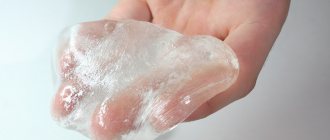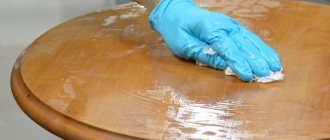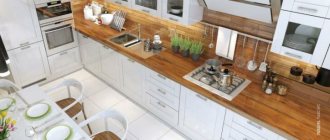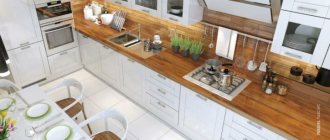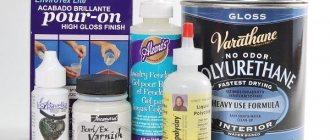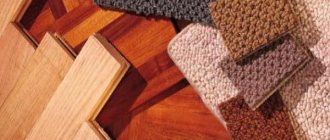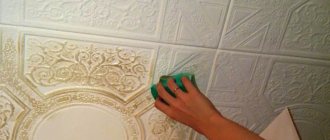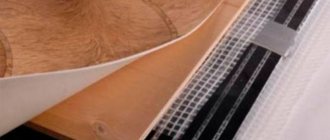The entrance area of any building, be it a country house or an office space, should not only be beautifully decorated and attractive in appearance, but also safe. Climbing the steps of the porch should, first of all, be comfortable. Nowadays, it is quite common practice to use materials for cladding such as ceramics, marble, etc. The glossy surfaces of such coatings look expensive and stylish, but it is easy to slip on them and get injured, especially if the steps are covered with snow or rainwater flows down them. Rubber covering for outdoor porches is convenient and extremely safe. A threshold with a rubber insert will protect you from falls. Anti-slip rubber products have many advantages. We will talk about their features, varieties and installation methods in our article.
Features and characteristics of materials
The main raw material used for the production of anti-slip coatings is crumb rubber. It is obtained by processing discarded car tires. And for this purpose several methods are used. From simple mechanical treatment to ozonation and barodestruction.
For rugs and other coverings, particles with a fraction of up to 10 mm are selected. They are mixed with polyurethane-based compounds and various dyes are added. For production, the pressing method is used. Moreover, there is a hot and cold method.
Fine tire crumb Source sportgrass.kz
Rubber coatings from tire crumbs Source mrrestavrator.ru
Rubber covering for outdoor porches is a popular material. Its use is widespread, and its purpose is difficult to overestimate. All educational institutions and administrative buildings are provided with such cladding for dangerously slippery surfaces. The construction of playgrounds for children's games and sports cannot be done without it. It is also required to be located in the pool area.
The excellent properties and growing popularity of the material are also appreciated by private developers. Rubber products began to be used on house steps, garages and balconies. Even in agriculture, rubber tracks and mats have found useful applications.
The main task of a rubber product is to ensure the safety of people when crossing areas lined with materials with a smooth structure. Additionally, such cladding acts as protection for the same tile from impacts that could deform it.
Slippery winter stairs Source nationaljournal.com
Rubber overlay on the edge of the step Source parket-sale.ru
But the range of advantages of the material is truly wide:
- Some products can last up to 50 years.
- Seasonal natural changes are not scary due to high elasticity.
- Excellent resistance to friction and other mechanical influences.
- Has anti-shock properties.
- Thanks to the shock-absorbing properties, movement on the material becomes particularly comfortable.
- Not afraid of aggressive chemical influences. Resists acids, solvents, various salts and alkalis.
- Retains all its properties in the temperature range from -40 to +70 degrees Celsius.
- Fungus and mold are not able to take root on the material.
- When wet, it retains anti-slip properties, and ice formations in cold weather are rare, minimal and easy to remove.
- Versatility of use, both inside and outside the building.
- Easy to install and compatible with other materials.
- An unusually wide range of products, from the most budgetary samples to exclusive options that are not inferior to carpets.
In the latter case, the price of the product is very high, which many consider to be a disadvantage. But this is justified by excellent quality and magnificent appearance. As for the rest, every consumer can find something that he can afford. True, the most budget materials most often have an unattractive appearance.
Anti-slip pad for porch steps Source lestnitsa.org.ua
Black toxic smog emitted by burning rubber Source author.today
Wooden stairs indoors
The stylish and cozy appearance of wooden stairs contributes to their widespread use in private and other construction. However, active use of this functional element of the building inevitably leads to a loss of aesthetic appearance.
How to reliably protect the structure and how to cover a wooden staircase inside the house is what worries many owners. There are certain categories of paints and varnishes for internal use. They reliably protect wood from exposure to water, sun and abrasion. These include:
When thinking about how to cover wooden steps of a staircase in a private house, you need to consider the following factors:
- Frequency of wet cleaning of stairs and use of detergents.
- The location of the stairs in the house relative to the exposure of the sun's rays to it and the duration of their exposure to the surface.
- Possibility of unhindered movement around the room after applying the protective composition.
Now let's move on to the direct study of the impregnating compositions themselves.
Paints
When it comes to the question of how to cover a wooden staircase, painting is a rather controversial decision. On the one hand, any paint will completely hide the texture of the wood. True, there is a partial solution to this problem - brushing first the wood and then the paintwork.
Moreover, some designers widely use this technique when decorating premises. If you paint the stairs in several multi-colored layers and brush them, you can achieve an interesting effect. But when choosing paint, you should always consider the overall design of the room.
The use of paint is recommended in case of a large number of defects on the wood - chips, dead knots or cracks. All this can be removed, puttyed, sanded and reliably covered under a layer of paint and varnish material.
As for the compositions themselves, the most optimal solution for wood would be to use oil paints. They take a long time to dry, but this temporary inconvenience is compensated by excellent protection. Drying oil, which is part of the paint, penetrates deeply into the wood and creates a reliable barrier to negative influences.
The film of modern oil paints is resistant to abrasion and has good resistance to ultraviolet radiation. This coating can also be subjected to wet cleaning using detergents.
How to cover the steps of a wooden staircase in a house while preserving the natural texture of the material, this task also often arises at the stage of protecting the wood. One solution would be to use varnishes. When choosing a varnish, it is advisable to know what kind of wood the staircase structure was made from. Varnishes offered on the market are divided into several types. Each of them has its own specific qualities.
Oily
These formulations are based on various oils of plant origin. The second important component is resins, natural or artificial. The resins react with shellac or sandarac and produce a composition with a concentration of about 45% percent.
These varnishes contain alcohol and, due to the fact that it quickly erodes when dried, it does not have a negative effect on the lower layers of wood. These varnishes are usually diluted with white spirit.
Alkyd
These compounds are resistant to temperature changes and resist moisture well. They are the most resistant to moisture. An important point when covering staircase steps is the absence of squeaking after treatment. In this regard, alkyd compositions are also good because they are resistant to vibration loads.
When painting, the varnish penetrates deeply into the material and highlights its natural beauty. The coating has a glossy or matte film, it all depends on the brand of varnish. It is convenient to work with varnishes on this basis because, despite their sufficient thickness, they have good fluidity.
Nitrocellulose
Such compositions are excellent for conifers, which by definition contain a lot of resin. Nitrocellulose varnishes dry quickly, giving a stain-resistant film.
It is worth noting that these compositions do not require the application of a preliminary primer. To obtain a higher-quality coating, a solvent is added to the composition before use - up to 5 percent of the total volume. This will avoid premature drying of the material.
Polyurethane
These varnishes are characterized by a long service life and prolong this quality of the processed material. They are also not devoid of decorative properties, highlighting the texture of the material well. Polyurethane compounds have much higher protection properties than their analogues.
After processing, a high-strength film is formed that is resistant to physical stress. Varnishes perfectly resist moisture and direct sunlight. Moreover, they protect the wood from pests. The only drawback is the rather significant price.
Polyester
These compositions for covering stairs are not as popular as the previous ones. The first and main drawback is the strong smell during operation. The second point is that the resulting surface is too glossy. This is not always true on flights of stairs.
Some tips for applying varnish
Before you varnish a wooden staircase inside your home, we suggest you familiarize yourself with a few tips for applying it:
- The optimal application option is to work with a disassembled object. Therefore, if it is possible to remove steps from the stairs, then it is advisable to do so.
- When applying, take into account the density of the compositions - parquet or floor varnishes are more fluid than those intended for painting stairs.
Oils
One solution to the question of how to coat a staircase in a wooden house is to use special oils. Modern oils have successfully competed with paint and varnish coatings.
They are endowed with high penetrating ability and decorative properties. These compounds also have good performance in terms of protective properties. They have antibactericidal properties, which prevents fungi and mold from penetrating the wood.
The basis of this type of wood impregnation is the following components:
- candellin wax;
- carnauba wax;
- linseed oil;
- jojoba oil;
- sunflower oil;
- beeswax.
The main benefits of using oils include:
- high water-repellent properties;
- significant extension of the service life of wood;
- absence of unpleasant odors during operation and after drying;
- ease of use, does not require special tools.
Stains
A fairly simple solution to the problem is to use various stains to cover wooden steps. These compounds have antiseptic properties and prevent wood from burning.
They can radically change the color of the staircase and add a fresh twist to the design. Often, after applying stain, the surface is additionally protected with a varnish coating. However, it is necessary to take into account the compatibility of the compositions.
Among the wide variety of stains on the market, the following main categories can be distinguished:
- Water-based formulations available in dissolved or powder form. Powders are more preferable because they make it possible to independently regulate the concentration and thus the shade of the future coating.
- Alcohol-based compositions that have a short drying time.
- Solvent-based compositions dry as quickly as the previous ones, but have a significant drawback - a strong odor during operation.
- Compositions based on wax and acrylic are easy to apply and dry quickly.
- Alkyd-based compositions, depending on the brand, combine several indicators of all previous stains.
After impregnating the wood with stain, it is usually treated with sandpaper. This allows you to avoid the swelling effect and remove the small pile that rises after impregnation.
Pastes
You can also use a non-traditional method to protect wooden stairs - apply a special paste to the wood. These compositions are made on the basis of linseed oil and beeswax. Pastes have different densities, which are selected depending on the type of wood. Harder varieties process formulations with a high oil content.
Work process
The work of applying any of the listed protective compounds is divided into three main stages:
- preliminary work;
- process of applying a protective composition;
- finishing.
Preliminary work consists of eliminating all visible flaws in the wood. Dead knots are cut out, cracks and chips are filled. Next comes grinding, during which the grain size of the sandpaper is constantly reduced. This allows you to achieve the highest quality surface.
Rubber coating options
In addition to porous products made from crumb rubber, there are materials made from vulcanized rubber. They are produced monolithic and have a homogeneous structure, that is, they are homogeneous. Both types can be used either independently or in combination with other materials. For example, edging with metal profiles.
Installation of the products is quite simple. Basically, the porch covering is glued to the surface of the steps using polyurethane-based compounds. But in special cases there is a need to use dowels. This option is suitable for arranging high-quality material with a beautiful appearance. It is fixed for many years and is not going to be changed soon.
Rubber step overlay Source stroysystem.com
Rubber pad edged with steel profile Source semiver.com
There is the possibility of obtaining exclusive models. They differ in inscriptions. Many organizations order their logos on rubber coatings. And there is a special type of product with advertising on the surface. And you can even get a discount for purchasing a product with someone else’s brand.
What to do to prevent the porch and steps from slipping in winter
In what ways can you effectively and quickly solve the problem of slippery steps and porch stairs today? Especially in autumn and winter, when smooth surfaces become especially dangerous. Of course, this means the use of all kinds of anti-slip devices and coatings on slippery surfaces. There are several materials that can be used to cover a porch to prevent it from slipping. Let's look at the most common ones and find out their pros and cons.
1) Anti-slip self-adhesive tape. It is a polyester tape with a vinyl or abrasive coating. Attached with an adhesive coating on one side. Pros: simple, quick and reliable installation, good anti-slip performance, large selection of colors, low price. Cons: not durable (1.5 million passes, 3-5 years), requires a smooth surface.
2) Anti-slip self-adhesive strips (linings) and corners. They have a rubber base and are attached using an adhesive coating applied to the bottom of the material. Apply to slippery steps of stairs and porches. Pros: simple, quick and reliable installation, protect steps from chipping and abrasion, wide range of colors, low price. Cons: not significant protrusions at installation sites, requires a smooth surface.
3) Aluminum corners and profiles with rubber inserts. They have an aluminum base, which is attached to the base with dowels and screws, and have a removable rubber insert. When using such corners and profiles, slippery stairs will no longer be dangerous. Pros: reliable installation, durable, have easily replaceable, inexpensive rubber inserts. Cons: labor-intensive installation that requires care, minor protrusions at fastening points.
4) Anti-slip joint between tiles. It has a rubber base and is attached to the seams of tile coverings. Pros: reliable installation, aesthetic appearance, low price. Disadvantages: labor-intensive installation process, technological difficulties with repair and replacement of this material, cannot be repaired, protrusions on the surface of the coating.
5) Aluminum corners and tile trims with removable rubber inserts. They have an aluminum base into which an anti-slip rubber insert is inserted. They are attached between or under the tiles directly when laying them. A slippery porch will become quite safe when using these materials. Pros: reliable installation, easily replaceable rubber inserts, durable. Disadvantages: labor-intensive installation process, technological difficulties with repairing and replacing aluminum parts, minor protrusions on the surface at fastening points.
These types of anti-slip coatings can be mounted on concrete, metal, ceramic, marble, granite and even wooden porches. They are waterproof, heat-resistant and can be used both inside and outside buildings.
Rubber crumb coating will make the stairs safe and visually attractive.
Well, what should you do if none of the above listed anti-slip coatings suits you, due to insufficient coverage of the surface of the steps. In this case, steps, slabs and crumb rubber coatings will help you. These materials consist of recycled rubber tire crumbs and a polyurethane binder. They are attached using polyurethane glue and can completely cover the entire step. Entry from the street using such a surface will be the safest of all available types of anti-slip surfaces. Pros: reliable, easy installation, covers the entire step and protects it from chips and damage, durability, evenness of the coating, wide selection of colors, maintainability, safety from injuries. Cons: high price.
To buy the product you like, just call the numbers listed below or leave a request.
What can be done to prevent the porch and stair steps from slipping in winter? What can be done to prevent the porch and stair steps from slipping in winter? What are the methods today that can effectively and quickly solve the problem of slippery steps and staircases? Especially in autumn and
steps
In rare cases, you can see the entire flight span consisting of monolithic rubber. It is used on a porch that experiences significant loads. As for the rest, separate overlays are produced for the steps, which are glued to the tread.
Rubber molding fits perfectly with any surface, be it concrete, wood, iron or even asphalt. Of course, the material fits well on any facing tile. Often the product has a small bend that wraps around part of the riser.
Cover with a bend for the riser Source kiensx.tomadamsforcongress.com
Aluminum accessories
Combined linings with an anti-slip effect are made from aluminum profiles, which can be used on different surfaces. Inserts made of rubber or other material with the desired properties are attached to the profile, after which the structure is fixed on the step.
Also on sale are L-shaped aluminum profiles, which are used in places with increased mechanical loads. They cover not only the surface of the step, but also the riser. As the rubber part wears out, it can be replaced with a new one.
Standard corner anti-slip pad for steps
Aluminum structures on the market are presented in the form of relief nets that are fixed to the porch. They have an additional dirt-repellent effect and help to quickly and easily clean the soles of shoes.
Important! For areas that are subject to heavy icing, aluminum coatings are not suitable, since in such conditions the anti-slip effect is reduced.
Rubber tiles
A material that is gaining particular popularity. It is used not only for porch steps. Modular rubber tiles can be seen on the floors of garages. The paths around the pools are lined with it. And for finishing the area in front of the house, special rubber paving stones are even produced, repeating all possible shapes of concrete paving slabs.
The coating has standard dimensions, like its tiled counterparts - 50x50 cm. In rare cases, you can see specimens with parameters of 100x100 cm. The thickness of the tiles ranges from 10 to 45 mm. And the thinnest one is best suited for cladding the entrance porch.
Porch made of soft rubber tiles Source womanadvice.ru
Paving rubber tiles Source domsporta.com
Modular tiles consist of two layers. For the top one, finely divided rubber crumbs are selected and mixed with the desired pigment. The lower damping layer consists of large fractions and remains unpainted (black).
We can say that this tile has no analogues and it contains a number of unique properties, remaining:
- aesthetic;
- flexible;
- injury-proof;
- elastic;
- absorbing all sounds;
- with excellent shock absorption;
- protected from vibrations.
Each specimen has side fastenings (bushings) to facilitate installation. In addition, the material is easy to cut to the desired size.
Rubber tiles with bushings on the sides Source msk.det-ploshadka.ru
Anti-slip coatings for external and internal stairs in a private house
Reliability and safety come first! Then comes a beautiful view and proper decoration. The use of stairs when ascending and descending must avoid the risk of injury.
If elderly parents or small, restless children live in the house, then you cannot do without an anti-slip coating.
Unforeseen injuries, such as fractures, muscle strains and bruises can permanently damage the health of household members.
How not to spoil the joy of living in your beautiful, comfortable home?
Roll coating
The material has a standard width of 1250 mm, and its thickness ranges from 6 to 13 mm. Excellent for staircases leading into administrative buildings. It is distributed over the entire required area, including steps. And they are secured using metal plates located at the bottom of the riser.
Rubber roll coverings for outdoors Source fitnesslook.ru
Rubber roll covering on the porch Source laminatepol.ru
But other uses are also possible. To save money, the roll is cut into pieces that cover each individual step. In this case, the prepared pieces are glued to the concrete base.
Anti-slip coating on porch steps: many ways to make them safe
Everyone knows firsthand how slippery the steps of a street porch can be after rain or snowfall. And some people even fell on them and received injuries. To protect yourself and your household or guests from such troubles, it is worth investing in anti-slip coating on the porch steps.
There are several types of materials capable of performing such a protective function. All of them will be described in this article, and all you have to do is choose the appropriate option.
Structurally, all types of such coatings can be divided into two types: the first in the form of narrow strips, strips and profiles and the second in the form of continuous coatings.
Tape overlays
There are quite a few varieties of narrow overlays. Let's try to navigate their diversity.
Types of overlays
They produce anti-slip coating on the porch in the form of narrow strips from materials such as rubber, rubber, PVC, and abrasive-coated tapes. They can be combined with anodized aluminum profile.
How to choose
When choosing one or another type of anti-slip pads, you should pay attention to the following parameters:
- Bandwidth. It can be from 15 to 100 mm, and in the case of an aluminum profile, even more.
- Its shape is flat or angular.
- Durability.
Abrasive belts have the shortest service life. Despite the fact that the fixation of hard particles is very strong, they wear out in 2-3 years.
- Additional functions. These include the possibility of replacing the anti-slip liner. There are also covers that glow in the dark thanks to built-in photocells.
- Installation method. If the porch has not yet been finished, you can consider embedded structures. In all other cases, in order not to spoil the steps, choose overhead or self-adhesive strips.
- Price and release form. Overlays can be sold in pieces of different lengths or in whole rolls, the footage of which is large for an ordinary porch of a private house.
- Appearance, color. The design of the entrance group is the calling card of your home, so even the shape and color of the strips glued to the steps should be in harmony with its exterior.
Perhaps the options shown below will help you with your choice
Seamless option
Porch coverings can be made completely monolithic. There is a special technology for this, which is performed in two ways. The more expensive method is carried out by spraying and requires special equipment. Another option involves manual work, which you can do yourself or entrust to a master.
Rubber covering on the porch, made using seamless technology Source vsenasklade.ru
Rubber application by spraying Source gidrocor.ru
The method is suitable for both internal and external use. But in the latter case, work must be carried out in dry weather, with an air temperature not lower than +5 degrees Celsius. And to create the mixture, you need to mix 12 kg of crumb rubber with 3.4 kg of polyurethane glue and add 1 kg of the desired pigment.
Coating technology:
- The porch surfaces are thoroughly cleaned of dirt.
- A primer is mixed, for which polyurethane glue and turpentine are taken in equal proportions.
- The steps are primed and time is given for the composition to dry completely. The expiration date is indicated on the glue packaging.
- The working mixture is prepared in the following sequence. Pour the crumbs into the container and mix thoroughly to break up the lumps. Continuing the movements, pigment is introduced. When the painting is finished, add glue and mix the mixture for another three minutes.
- The composition is evenly applied to the surface with a spatula.
- Using a roller dipped in kerosene, the laid mass is rolled tightly.
Within a day, the resulting smooth coating can be used. And the main advantage of this method is that any surface can be treated this way. From smooth planes to curved rough spheres. The finished coating is easy to clean and water does not accumulate on it.
Seamless self-leveling coating made from crumb rubber Source regionoperator.ru
Tamping rubber crumbs using a seamless method Source mrrestavrator.ru
How to make your outdoor porch safe
This is not to say that the problem of protecting a porch is unsolvable or requires enormous costs. The question most often lies in a different plane - how to make a covering for an outdoor porch as efficient, durable and inexpensive as possible. You can, of course, simply limit yourself to laying a budget solid rubber mat on the porch; in practice, such a covering gives only a partial effect. At first, the rug works well and collects dirt and water, but as moisture, snow or ice seeps under the base of the rubber covering, the rug begins to slip and loses its protective qualities.
A special rubber coating for outdoor porches resists slipping best. Plastic, metal, polyethylene and polypropylene, even with perforations or grooved profiles, are the worst options for covering a porch.
Today, to effectively protect the porch on the street, several coating options are used:
- Overhead corners and strips laid on porch steps, especially on the first and last steps of the stairs;
- A universal covering option for any outdoor staircase in the form of overhead rubber steps made from pressed rubber crumbs;
- Fixed aluminum and rubber combs, fixed at the entrance landing of the porch and in front of the first step of the stairs on the street;
- Perforated rubber sheets, panels, mats installed on porch areas and areas of the street adjacent to the porch.
Important! At first glance, it may seem unnecessary to install rubber surfaces outdoors around the porch stairs. But according to statistics, almost a third of injuries and falls occur in the area adjacent to the porch on the street.
Ironically, these are the areas of the street that become the most icy and accumulate the most snow.
Overlays and corners
If the decoration of the porch is rich and splendid, then it would be a pity to hide such beauty even under the best covering. But, in order to protect pedestrians, only the very edges of the steps can be treated. This will be enough to prevent you from slipping on the stairs.
Aluminum anti-slip profile with rubber insert Source kantiere.ru
Rubber strip on the edge of the step Source protect.rf
There are special corner pads that are secured with self-tapping screws, having previously prepared holes for them. You can also glue a narrow rubber strip to the edge of the step. It will not allow your foot to ride on a slippery surface and will not spoil the overall appearance.
Abrasive tape
One of the simplest and cheapest options to secure your porch.
Abrasive tape is essentially regular sandpaper with an adhesive layer.
You can use this type of sandpaper by simply cutting it into strips. Just one piece of advice: it’s better to round the edges of the strips so that they don’t ride up during use.
And another idea - a non-slip coating made of rubber crumbs:
Rugs
The easiest way to deal with slippery surfaces. Rubber mats come in different sizes. From small strips on each step to a covering that occupies a large area in front of the front door. Additionally, the products help get rid of dirt on shoes. But there are options when such a simple element can even act as decoration.
Decorative rubber mats for porch steps Source ca.news.yahoo.com
Anti-slip treatment for porcelain stoneware
Anti-slip pad on steps.
Ceramic granite is becoming an increasingly popular finishing material. Its appearance and performance characteristics are almost equal to those of natural stone. At the same time, the cost of porcelain tiles is much lower.
It is impossible to grind and burn porcelain stoneware, since it contains polymers that give the material viscosity. In addition, plasticizers are unstable to high temperatures. The coating can be made non-slip only with the help of special inserts. Cuts are made under them, which can be single or cover the entire surface of the steps.
Inserts are made from the following material:
- Dense and wear-resistant rubber. It is resistant to abrasion, ultraviolet radiation and chemically active substances. If damage occurs to the inserts, they can be easily and quickly replaced without stopping movement.
- Granite bars. The bars are matched to the color of the steps or in a contrasting design. The parts are connected using epoxy glue, which protects the joint from moisture.
In order not to waste time and effort on processing porcelain stoneware, you can purchase tiles that have anti-slip corrugations pre-made. Snow and water will be forced into the recesses of the tiles, preventing unwanted sliding.
If you want granite, be prepared for bush hammering
Granite porches are very durable, strong and look good. Only polished granite is what causes injuries. How to avoid this? There are several options for treating granite to make it safe.
Treatment can be carried out at high (+600 °C) temperatures.
This treatment destroys the polish, but gives a rough surface on which even thin pins will not slip.
This treatment costs approximately 700 rubles per 1 m2. Inexpensive compared to paying sick leave for the injured person.
There is another option - bush hammering, that is, processing the surface of a granite slab with a coarse-grain grinder.
For processing, they pass over the surface in stripes - and you get a completely non-slip coating
Finally, thin cuts can be made in granite into which rubber strips can be inserted. They prevent slipping.
If we are talking about porcelain stoneware, then notches are made on it for stability. And in addition, there are ready-made tiles with an abrasive strip on sale
Installation recommendations
All anti-slip coatings are secured with adhesive, screws, clamping strips, or have a ready-made adhesive base. In any case, first mark the stairs using a pencil or marker, mark lines for tapes, tiles, and corners. If necessary, make holes for fasteners (usually at a distance of 3.5–4 cm from each other).
Important! The easiest way to glue the coating is if it has an adhesive base: you just need to remove the protective layer and apply the material to a clean base.
An anti-slip coating on a wooden staircase is most often attached to polyurethane glue. For concrete steps, concrete self-tapping screws are used, and if they are ineffective, dowels are used, which prevent the hardware from jumping out of the groove.
Installation of anti-slip strips
If installed correctly, anti-slip materials will serve for many years and will bring real benefits to owners and guests.
Modern anti-slip designs
Standard rubber pads have recently been replaced by modern coatings, which are considered more effective and convenient to use.
Luminescent tapes
This group includes materials used against slipping and that can glow in the dark. The glow occurs due to the application of special composition tapes to the surface, which accumulate ultraviolet radiation and release it in the dark.
In the production of luminescent coatings, materials of different compositions are used, but they have the same operating principle. The quality of the base affects the consumer properties of the tape. These include the duration of the glow, its intensity and the safety of the coating.
Luminescent anti-slip tape on steps
Luminous anti-slip tapes can be used both outside and indoors. They help arrange poorly lit staircases, escape routes, dark entrances to the house, and are useful in case of a power outage.
Important! Luminous coatings are easy to install on any surface, since they are made on a self-adhesive base.
Vinyl tapes
Anti-slip coatings made of elastic structured vinyl look like regular tape. They are produced in the form of a tape, rolled into a roll, and their surface does not contain standard abrasives.
The anti-slip effect is achieved by structuring the vinyl, which acquires a grainy texture. Typically, vinyl tapes are used on internal steps or in the bathroom, or in other rooms where it is important to ensure complete safety of walking. They are ideal for spa centers, swimming pools, children's rooms, hospitals.
Anti-slip non-abrasive vinyl tape with self-adhesive surface
You can walk on vinyl flooring barefoot, as it is quite soft, despite the slight roughness. The vinyl surface is easy to clean from dirt, resists abrasion, and is resistant to water, grease, petroleum products, and detergents. To install the tape, it is enough to remove the bottom protective layer and stick the material to the base in literally one movement.
